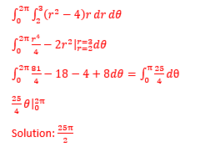I was given the following problem:

I found that \(2\leq r\leq3\) using the equality \(x^2+y^2=r^2\) and then using \(z=x^2+y^2-4\) and \(x^2+y^2=9\). For \(\theta\) I assumed that it ranged from \(0\) to \(\pi\) because of the \(z=0\). But, I realized that on the \(x-y\)-plane the equations trace out full circles and therefore I should use \(0\leq\theta\leq2\pi\). Is this true?
Here is my work:

I found that \(2\leq r\leq3\) using the equality \(x^2+y^2=r^2\) and then using \(z=x^2+y^2-4\) and \(x^2+y^2=9\). For \(\theta\) I assumed that it ranged from \(0\) to \(\pi\) because of the \(z=0\). But, I realized that on the \(x-y\)-plane the equations trace out full circles and therefore I should use \(0\leq\theta\leq2\pi\). Is this true?
Here is my work:

